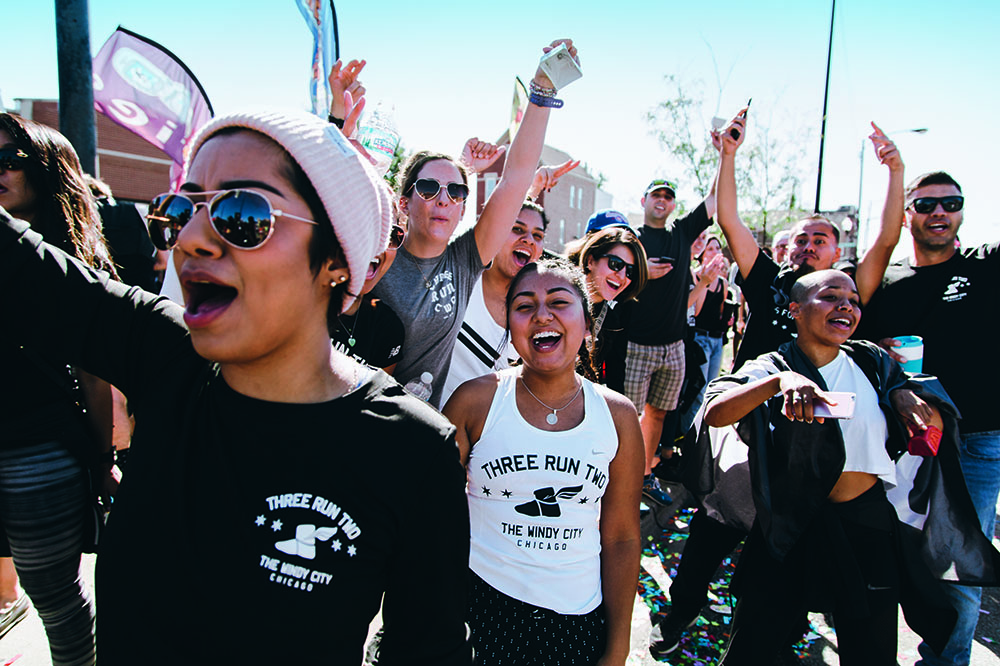How Cheering Others Can Make You A Better Runner
Rooting for other runners can actually boost your spirits and performance.
Raise your hand if a spectator gave you a motivation boost during a race – if a funny sign made you smile, an ice lolly saved your soul at kilometre 32, a stranger’s high-five put more oomph in your steps. Now, keep it up if you’ve been a solid spectator yourself. Hand still up? It should be – and not only for a vague sense of race karma. Turns out, cheering for other people might actually help make you a better runner.
The reason why is something psychologists call ‘self-efficacy by vicarious experiences’, a fancy way of saying you’re more likely to believe you can accomplish something when you see other people getting it done. “You think, If they can do it, I can do it too,” says Cindra Kamphoff, PhD, professor of sports psychology at Minnesota State University and author of Beyond Grit: Ten Powerful Practices to Gain the High-Performance Edge.
Simply believing you can do something has pretty powerful perks. For one, you’re more likely to stick with a commitment when things get tough. For example, Penn State University researchers looked at people with knee osteoarthritis and found that those who were more confident in their physical abilities early in the day were more active throughout the day, despite pain. And in a separate University of Illinois study, people who had an I-can-do-it attitude were more likely to stick to their exercise regimens long-term.
RELATED: 10 Mental Tricks To Run Stronger
Kamphoff, a competitive runner herself, saw this effect first-hand while watching the US Olympic Marathon Trials. “I never saw myself as an Olympic runner, but my pace was similar to some of the people towards the back,” she says. “So I imagined myself in their shoes, and it gave me more motivation in my training.” While Kamphoff didn’t end up qualifying, her renewed commitment to running helped her win a popular marathon a few years later. Here are three other ways spectating can boost your own performance.

You’ll feel less stressed
People who support others have less activity in brain areas associated with stress than those who receive support, according to a Psychosomatic Medicine study. Stress sucks, obviously, but it also affects performance: university athletes were nearly twice as likely to develop injuries during stressful academic weeks (such as mid-year exams and finals) than during periods of low academic stress, according to The Journal of Strength and Conditioning Research.
You’ll learn from all parts of the pack
Spectating allows you to see racers you don’t get to as a participant, and there’s something to glean from each pace group. “If you’re usually at the front, you might think running is all about competing; if you’re at the back, you never see how the elites really glide,” Kamphoff says. Spectating allows you to take note of the form and focus of the pros, while gaining inspiration from the grit of the back of the pack.
You’ll know what to expect
“When people tell me they want to qualify for an event, I tell them to watch the specific event,” Kamphoff says. “Taking in the exact surroundings and seeing other people model the course is a powerful thing.” Let’s say at Comrades you stood at Polly Shortts, and saw a variety of runners struggling – elites, athletes with disabilities, members of your own pace group; the experience would help you develop more inner strength for when you tackle the hill yourself. “They’re modelling the experience for you, so you know what to expect and can feel more confident in your own abilities when the time comes.”
Supporter Squad Secrets
The famous Wellesley College cheer zone, or ‘Scream Tunnel’, is near kilometre 21 of the Boston Marathon. Steal their sideline tips.
Divide the day
You’ll lose steam if you stay on the sidelines from start to finish. “I cheer for a couple of hours, then play games on the grass or break for lunch,” says Fiona Chung, a senior student. “Track your friends who are running, and head back when they’re close.” Some larger races have apps that make it easy.
RELATED: Train Your Brain & Nail Those Difficult Runs
Create a sign
“A sign increases your interaction with the runners,” says Molly Hoyer, a senior student and res leader. Her residence makes around 500 signs to wave at the event every year. Not sure where to start? Hoyer suggests referencing the host town. “It gives locals pride in their city, while welcoming people from out of town.”
Be personal
For Hoyer, one-on-one interactions are what cheering is all about. “I love looking for identifiers – a name on a bib, a fun costume – and shouting at the owners,” she says. “You never know if people have anyone else on the course cheering for them.”
Cheer for yourself
It’s easy to be hard on yourself but supportive of others, so take note of how you didn’t withhold cheering from any racer – no matter their form or pace. “Hold on to that positivity, and remember that you deserve the same support from yourself,” Hoyer says.
READ MORE ON: crowd support motivation

